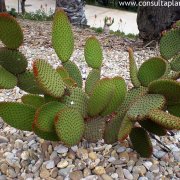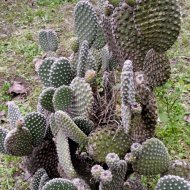Care of the cactus Opuntia microdasys or Angel's-wings |
|
The genus Opuntia, family Cactaceae, includes some 300 species of cacti native to Mexico, the USA and Central and South America. Some species are: Opuntia microdasys, Opuntia linguiformis, Opuntia leucotricha, Opuntia engelmannii, Opuntia bergeriana, Opuntia santa-rita, Opuntia rufida, Opuntia robusta, Opuntia ficus-indica, Opuntia durangensis, Opuntia subulata, Opuntia polyacantha, Opuntia lindheimeri, Opuntia aciculata, Opuntia basilaris, Opuntia atrispina, Opuntia valida, Opuntia macrocentra, Opuntia chlorotica, Opuntia auberi, Opuntia vestita, Opuntia spinulifera. Common names: Angel's-wings, Bunny ears cactus, Bunny cactus, Polka-dot cactus. Scientific synonyms: Opuntia engelmannii var. linguiformis, Opuntia lindheimeri var. linguiformis. This species is native to central Mexico. They are erect cacti with flattened green segments with aureoles of small thorns called star-shaped glochids. In some varieties these glochids are white and in others they are reddish. The flowers are yellow and bloom in summer; in pot it's more difficult for them to bloom. Angel's-wings is used in pots due to its small size but is also used in rockeries and in cactus and succulent gardens. Opuntia microdasys needs full sun exposure for adult plants and semi-shade for cuttings and young plants. The winter temperature must be above 5 ºC (41 ºF). The soil can be a mixture, in equal parts, of coarse siliceous sand and leaf mulch. Water frequently with little water in spring and summer waiting for the substrate to have dried; reduce watering in fall and do not water in winter. Fertilize in autumn with organic matter to promote flowering. Bunny ears cactus is a plant very resistant to diseases and drought but sensitive to excess water. Opuntia microdasys is propagated in early summer by cuttings from segments buried 1/3 of their size. |
Images of the cactus Opuntia microdasys or Angel's-wings |
Find plants
Opuntia microdasys or Angel's-wings | Care and Growing
© 2026 FavThemes







